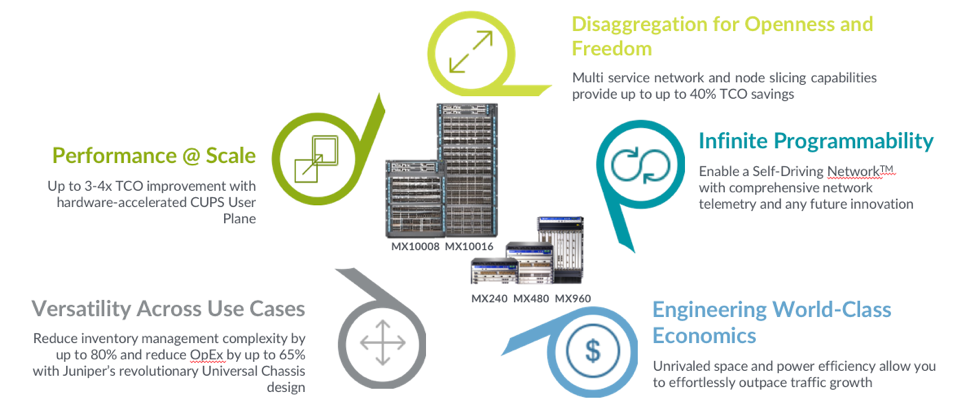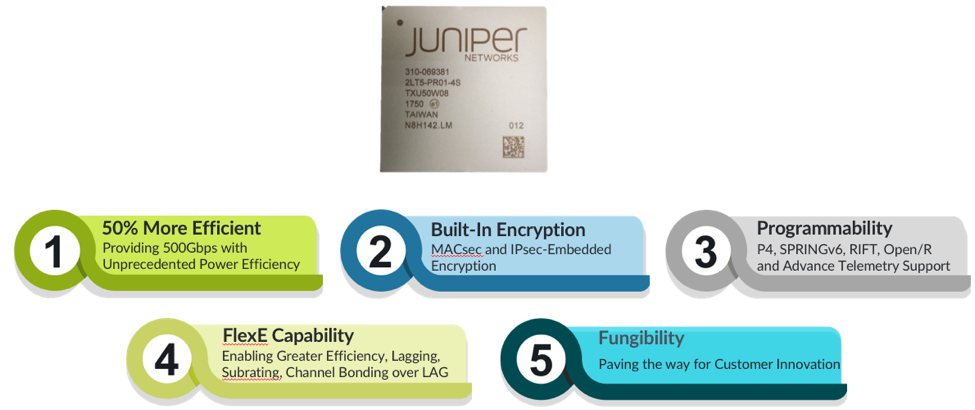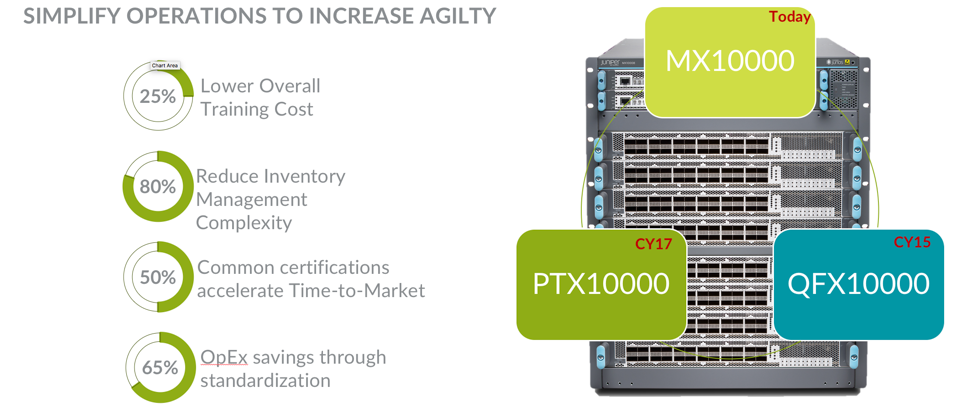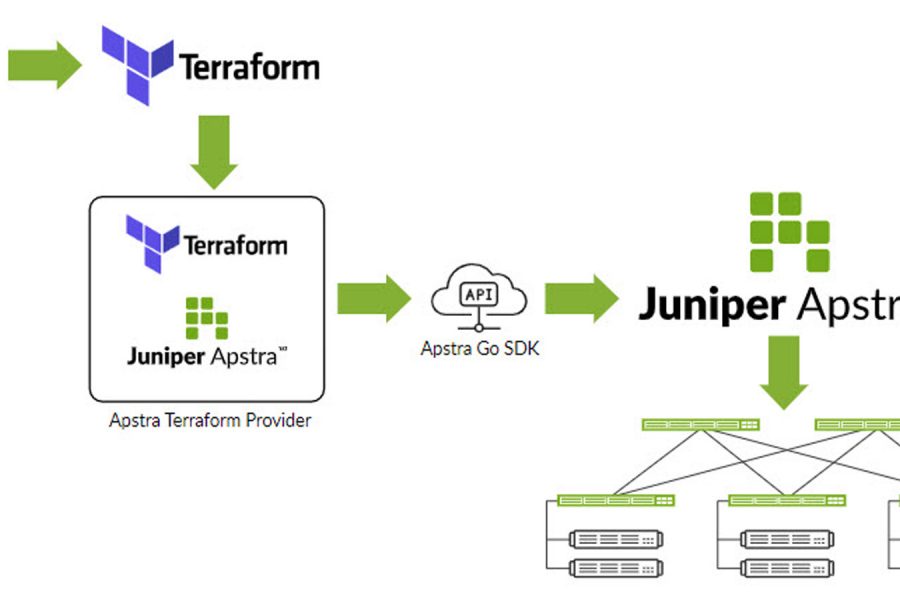When it comes to the future of networking, and specifically the role of routing, there are many known opportunities. You’ve read about them or maybe it’s come up in conversations with friends. 5G is going to supercharge your smartphone. IoT is going to connect everything around you. SD-WAN will give enterprises a new, easy way to organize and manage their IT infrastructure.
But just as important are the unknowns – and the key here lies in the ability to adapt to new services, new user expectations, new networking protocols and more. Protecting against the unknowns means leveraging an adaptable, flexible and programmable routing platform.
Some believe that routing is destined to become a niche market, reserved to support a subset of complex business and residential services for traditional service providers as other services move to the cloud. Others are convinced that the public cloud, leveraging merchant silicon and software disaggregation, is sufficient to address all current and future routing needs. And yet others feel that, with SDN and NFV, all routing functions can be virtualized and run on x86, with zero capital impact to scale services or packet performance.
But there is another, more compelling option. With the introduction of the MX Series Fifth Generation (5G) Universal Routing Platform, Juniper Networks is redefining the role of routing for the next decade.
The MX Series 5G Universal Routing Platform is specifically designed for service providers dealing with new emerging and secure services rooted in 5G, IoT, SD-WAN and other unique services built using their own tools and platforms. These services have the potential to unlock great opportunity for operators looking to move beyond just connectivity for their customers. But just like it was nearly impossible before 2007 to predict the rise of smartphones, we can’t say with 100 percent confidence today that we’re aware of every implication that these and other services will have on the networks powering them.

That’s why Juniper designed its MX Series routers from the start with our service provider and enterprise customers in mind, progressively evolving it over the years with investment protection always top of mind.
The first generation simply solved the network-connectivity issue. The second generation then extended the reach of those networks. The third generation introduced carrier-grade reliability and today’s fourth generation routers converge business, residential and infrastructure services into a single platform. Now, the 5th generation is designed to enable businesses to join the cloud era by economically delivering next-generation and secure service performance at scale.
What defines the 5th generation?
With the pace of innovation throughout the industry today, service providers are largely turning to software disaggregation, NFV and telco cloud without necessarily considering other alternatives. But what if the network infrastructure had the same level of programmability as the x86 architecture powering nearly every server and personal computer around the world? The secret to the longevity and robustness of Juniper’s MX Series has been its silicon programmability. Juniper has brought more than 20 years of engineering prowess and continuous innovation to the development of the MX. And that continues with the MX Series 5G Universal Routing Platforms, with new Juniper Penta Silicon, ensuring our customers’ investment (and insurance against the unknown) is protected for years to come.

Note: 50% more power efficient compared to existing Junos Trio chipset
Juniper Penta Silicon, a next-generation chip based on 16nm technology, provides a 3x bandwidth increase per slot for the MX960, MX480 and MX240 5G Universal Routing Platforms, continuously driving world-class economics by improving system efficiency at 0.5 watt per gigabit. And to contend with in-flight data security concerns, Juniper Penta is the only chip featuring integrated MACsec and IPsec encryption, designed to enable customers to originate and terminate thousands of IPsec sessions at scale without sacrificing performance. With Juniper Penta Silicon, end-to-end security becomes more pervasive across 5G, IoT, cloud and other network connections.
Scaling next-generation, high capacity 5G services requires an agile and distributed infrastructure layer leveraging Control User-Plane Separation (CUPS). And by drastically improving the user plane performance with hardware acceleration, service providers can gain a solution that is up to 3-4x more efficient at scale then a completely virtualized CUPS implementation.
As the only standards-based 5G CUPS hardware-accelerated user plane available, the MX 5G Series Platform adheres to Juniper’s core values of openness and interoperability. By leveraging a standard 3GPP-Sx interface, the new MX Series’ hardware-accelerated 5G user plane works seamlessly with third-party virtual control planes in a heterogeneous environment. Mobile operators can rest assured as they determine the best architectural path for implementing 5G, that Juniper supports freedom of choice for their future applications and services.
And as service providers prepare for their 5G and IoT deployments, Juniper’s new hardware-accelerated 5G user plane is supported on existing MX Series routers through a simple software upgrade. Service providers can leverage Junos Node Slicing to enable converged services (wireless and wireline) on deployed platforms to deliver the ultimate investment protection. Leveraging the networking infrastructure to economically scale next-generation services in an open standards environment is another attribute that defines the industry transition to the 5th generation.
To create an agile infrastructure that supports next-generation service delivery, platform versatility across multiple use-cases is of paramount importance. Versatility is needed to optimize the capital investments required to deploy 5G, IoT and secure business services simultaneously, as well as to simplify operations. This is why Juniper pioneered the universal chassis, designed to support a full spectrum of networking use-cases across data center IP fabrics, WAN backbones and, with the introduction of MX Series-specific line cards, service-rich edge applications. Juniper is the only company to simplify customer operations by up to 80 percent with a single chassis type across multiple different use cases.
 Note: Percentages based on Juniper analysis test cases against comparable systems.
Note: Percentages based on Juniper analysis test cases against comparable systems.
Networking innovation is happening in the blink of an eye. Facebook developed Open/R. The IETF is creating a new data center routing protocol, RIFT, that is expected to boost network efficiency by 35%. And there are many more – both known and unknown. The pace of innovation is creating anxiety that today’s purchasing decisions will create significant disruption down the road when new developments render existing technology obsolete. Service providers need network evolution without the disruption to their existing business.
But even worse than making the wrong decision is making no decision at all.
Fear of the unknown can paralyze companies, causing them to fall behind and become less competitive. Fortunately for the networking industry, Juniper is eradicating these anxieties by engineering the only platform – the MX Series 5G Universal Routing Platform – that is designed to provide investment protection for years to come with near-infinite programmability, ultimate versatility and uncompromising security and performance at scale to support a future of innovation.
Forward-Looking Statements
Statements in this blog post concerning Juniper Networks’ business, strategy and focus; the expected future of the networking industry and routing in particular; the future direction of our products and expected impact on the industry and benefits to customers; and our overall future prospects are forward-looking statements that involve a number of uncertainties and risks. Actual results or events could differ materially from those anticipated in those forward-looking statements as a result of several factors, including the factors listed in our most recent report on Form 10-K and subsequent quarterly reports on Form 10-Q filed with the Securities and Exchange Commission. All statements made in this blog are made only as of June 12, 2018. Juniper Networks undertakes no obligation to update the information in this blog post in the event facts or circumstances subsequently change after the date of this blog post.
Statement of Product Direction
In this blog post, we may disclose information related to our development and plans for future products, features or enhancements (“SOPD”). SOPD information is subject to change at any time, without notice. Except as may be set forth in definitive agreements, we are not providing any assurances, or assuming any responsibility, that future products, features or enhancements will be introduced. Except as may be set forth in definitive agreements, customers should not base purchasing decisions upon reliance of timeframes or specifics outlined in an SOPD, because we may delay or never introduce the future products, features or enhancements.


